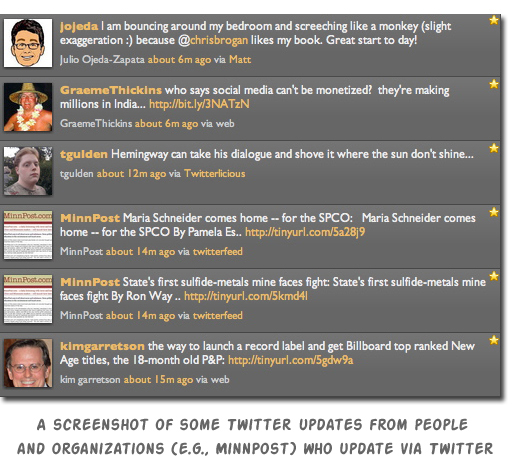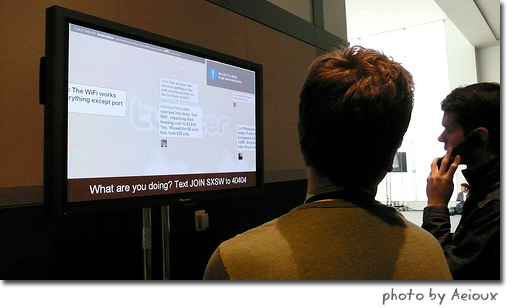 Every day there seems to be an uptick in the number of people who are online and interested in connecting with friends, family, colleagues or others where even a digital relationship might end up as meaningful.
Every day there seems to be an uptick in the number of people who are online and interested in connecting with friends, family, colleagues or others where even a digital relationship might end up as meaningful.
The continued growth of social networks is the strongest indicator of that trend, but the explosion of microblogging is another that bears watching, is worthy of your participation sooner-rather-than-later, as it’s already beginning to shift how early adopters in Minnesota are connecting with one another.
If you’re reading this blog post — whether directly on Minnov8, through an aggregated feed like the one at CentralStandardTech, or a publication we support with our content, MinnPost — you’re already familiar with blogging.
Though blogging is still one of the best ways to connect with people, inexpensively self-publish, create search engine friendly frequently updated content, or be a ‘container’ in which one can place value and position oneself as a a thought leader, good blogging requires significant time and effort in order to build and maintain an audience.
Microblogging, on the other hand, is a method to quickly publish small snippets of commentary or value — usually 140 characters or less that is somewhat like a persistent instant message, public in nature — and is therefore much easier to update when the mood strikes. Add to that the ability to make a brief comment and include a web link URL if so desired (so people can go out and read or view what you’re pointing them to on the Web) allows anyone publishing in this way to have their “followers” or audience quickly read that snippet, comment on it, forward it on, or let it stream by as other content appears from other followed microbloggers.
Minnesotans have embraced microblogging and its promise is that it will help to shift the way we all connect with one another, are alerted to items of interest, and even to collectively be engaged in running commentary like what has been exhibited during the various presidential or vice presidential debates where people were making real-time comments sent over Twitter.
The first mover in the microblogging space was Twitter. During the 2007 South by Southwest conference in Austin, TX, Twitter setup up 51″ displays that showed the ongoing stream of “tweets” as they’re called, alerting attendees to parties, bands and other must-attend venues. In a short time, many of the top bloggers attending were gushing about Twitter, and many of us following those bloggers signed up and starting using Twitter to see what all the fuss was about with this new service.
 Unfortunately, as Twitter exploded in use it had scalability issues. The site and service was often down, updates didn’t refresh properly, and the outcry from the tech community was relentless. One reason its use grew so quickly was not just the number of people signing up and using it, but also because Twitter (perhaps too early) released an application programming interface (API) that enabled developers to create new applications that used the underlying Twitter architecture.
Unfortunately, as Twitter exploded in use it had scalability issues. The site and service was often down, updates didn’t refresh properly, and the outcry from the tech community was relentless. One reason its use grew so quickly was not just the number of people signing up and using it, but also because Twitter (perhaps too early) released an application programming interface (API) that enabled developers to create new applications that used the underlying Twitter architecture.
If you’d care to view a dizzying array of applications making use of the Twitter infrastructure, you can do so here.
This didn’t stop people from using it, but the pressure made them address it quickly. It also helped other microblogging services obtain new users such as FriendFeed (an aggregrator of all your digital breadcrumbs left around the internet); Pownce; the open source identi.ca; and even a recently introduced private, enterprise-class version called Yammer.
Uses of microblogging are numerous and include everything from instant notifications of earthquakes, grassfires and other events, to live updates from news organizations, political campaigns and even auto-microblog-postings when a blog post or article is published by a microblogging person or organization.
This is one way Minnesotans are using microblogging. Here’s a random list of microbloggers to give you a sense of what’s out there and whom you could follow:
+ Minnesota Historical Society
+ KARE 11
+ MinneMom
+ Minnov8
+ Finally, here’s a Twitter search for tweets within 100 miles of Minneapolis, which will give you a sense of the volume of people actively engaged in this service within Minnesota.
IS TWITTER THE PERFECT COMMUNICATION MEDIUM?
Not by a long shot and some have even pointed out the uselessness of microblogging. But if you consider how the internet, web and access to it with desktop/laptop computers, smartphones and netbooks has made it even more important in all of our lives, then evolutionary communication mediums like microblogging are important stepping stones along the path toward richer, more robust and deeper human connections.
Some find microblogging a distraction, especially since real-time updating clients have emerged (e.g., Twhirl) that require fairly frequent attention be paid as messages keep appearing and then scrolling off the page into the ether.
Others point out that there is trouble with microblogging exacerbating the negative trend of a “sound bite” culture since too many people already focus only on the “headlines” and not the “article or story”. This headline-only nature is akin to how many people only skim newspaper headlines with disturbing assumptive results, “Carjacking in St. Paul by Two Teenage Males” with the article stating, “Today’s apparent carjacking victim realized she was completely unaware of any danger as two Roseville teenage boys pulled her out of her rear-engined car as flames began shooting out from under the hood.”
Even BusinessWeek has weighed in with several articles, most importantly this one from May of 2008 entitled, “Why Twitter Matters“:
Businesses such as H&R Block (HRB) and Zappos are now using Twitter to respond to customer queries. Market researchers look to it to scope out minute-by-minute trends. Media groups are focusing on Twitterers as first-to-the-scene reporters. (They were on top of the May 12 China earthquake within minutes.) Loads of new applications and services are growing around the Twitter platform, leading some to suggest that the microblogging service could become a powerhouse in social media.
More likely is that Twitter, Pownce, Yammer and other microblogging ‘platforms’ will continue to evolve and increasingly become personalized conduits within which alerts, notifications, links and even GPS-location based photos or updates will be sent to those following the person or organization sending the message.
One thing is clear, however, and that is Minnesotans have already embraced microblogging and are incorporating it into daily life.
To learn more:
+ The Microblogger: a blog about microblogging (is this paradoxical?)